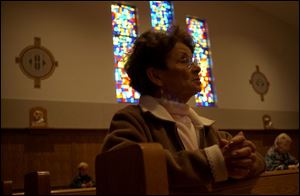
Effort to forge interfaith harmony had great success, but not always
4/9/2005
Rita Schmitz found the funeral Mass for John Paul II at Bellevue Immaculate Conception Church last night "very uplifting."
The unprecedented sight of dozens of spiritual leaders of the world's diverse religious groups gathering in Rome for a papal funeral testified to Pope John Paul II's lifelong efforts to promote interfaith dialogue and harmony, according to a leading scholar on religious pluralism.
"Time and again he emphasized how critical interfaith dialogue was, and how developing relationships with people of other faiths would help the process of peacemaking," Harvard University professor Diana Eck said in a telephone interview yesterday from Cambridge, Mass.
John Paul II achieved many interfaith firsts during his lifetime, including being the first Pope to visit a synagogue and a mosque. He also met with the Dalai Lama, the Tibetan Buddhist leader, at least four times, and visited India, the world's largest Hindu nation, in 1991.
In the aftermath of Sept. 11, 2001, John Paul brought together more than 200 religious leaders from around the globe for a Day of Prayer for Peace in Assisi, Italy, in January, 2002.
"... At the Pope's initiative, [the event] included Hindus, Buddhists, Native Americans - leaders from across the religious spectrum," Ms. Eck said. "The Day of Prayer for Peace increased the visibility of the papacy in promoting interfaith gatherings."
But there were some goals that eluded John Paul, including his hope of visiting Russia to bridge a historic rift with the Russian Orthodox Church. In August, Patriarch Alexy II, head of the Russian Orthodox Church, rebuffed the Pontiff's request and said he was not welcome in Russia.
"There were some Orthodox clergy at the funeral [yesterday], but he did want to go to Russia and did not make it," said Ms. Eck, director of the Pluralism Project and professor of Comparative Religion and Indian Studies at Harvard.
The Pope had tensions with Buddhists over his 1994 book, Crossing the Threshold of Hope.
"He has a chapter titled 'Buddha?' with a question mark that really raises the question of whether Buddhism is a negative, world-denying religion that is too interior-minded and not concerned with the development of the world," Ms. Eck said.
The Pope says in the chapter that Buddhism "is in large measure an atheistic system" and warns Christians against adopting such Buddhist ideas as meditation and asceticism. "Some of the things he says about Buddha in that chapter are hurtful and, in fact, not true," she said. "When he visited Sri Lanka in 1995, the Vatican issued a kind of apology before he went, about things that might have been misunderstood. Some Buddhist leaders boycotted his trip."
On the other hand, the Vatican held constructive talks with Buddhist leaders and was involved in exchanges between Catholic and Buddhist groups, she said.
Promoting dialogue with various world religions did not imply that the Pope considered theological compromises or questioned Catholicism, she said.
"He was an inclusivist Christian, not exclusivist in his view of people of other faiths," Ms. Eck said. "I think he walked a very fine line between outreach to people of other faiths - which he considered absolutely a critical issue in seeking peace - and maintaining the integrity of one's own faith."
Among those being discussed as a possible successor to John Paul II is Cardinal Francis Arinze of Nigeria, former head of the Pontifical Council on Interreligious Relations. "On many of the issues of theology and social and cultural issues, Cardinal Arinze is considered a conservative," Ms. Eck said. "But in terms of interfaith dialogue, he has more experience."
Contact David Yonke at:
dyonke@theblade.com or
419-724-6154.